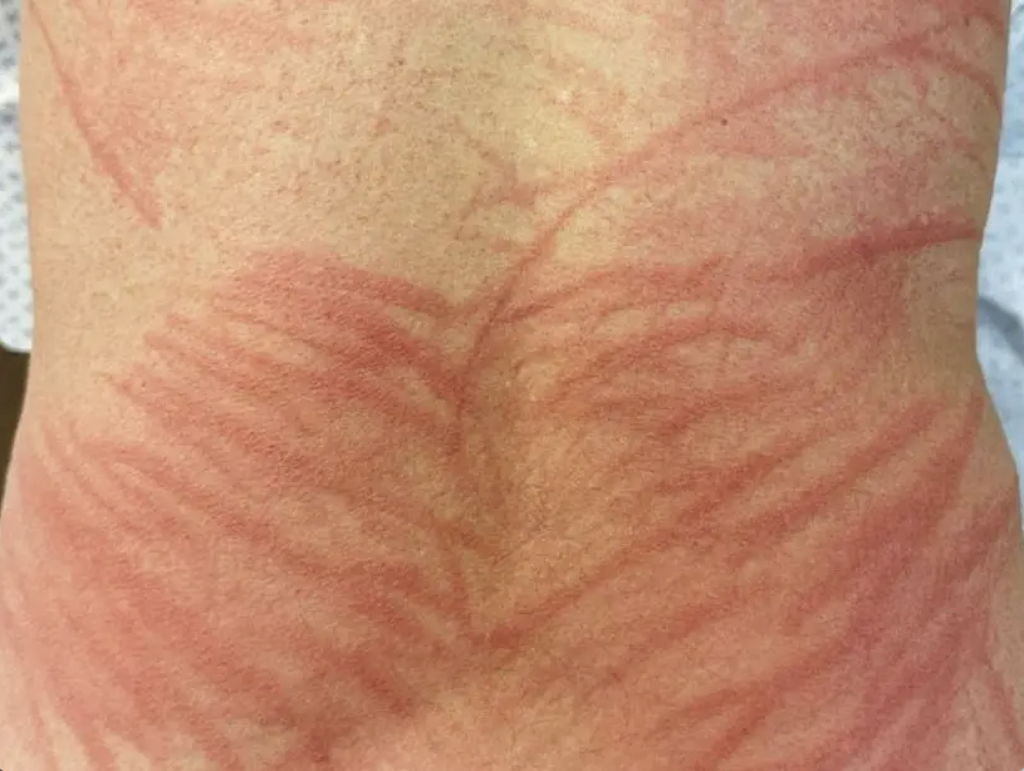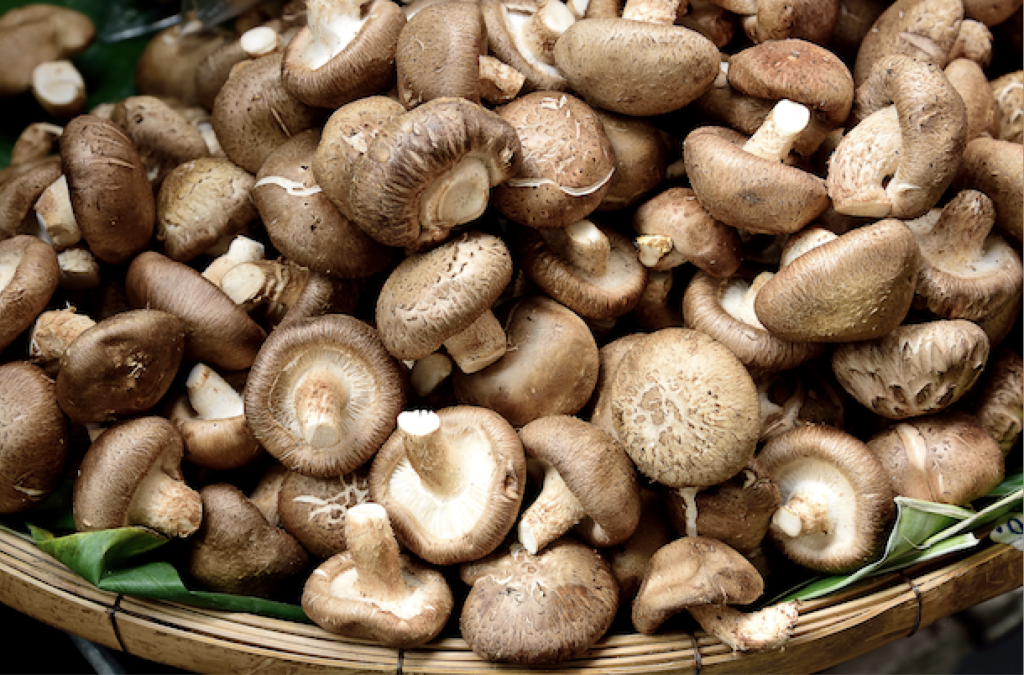
Shiitake mushrooms (Lentinula edodes) are a healthful and nutritious culinary delight—provided they’re cooked thoroughly. Eaten raw or undercooked, however, they can trigger a florid dermatitis in some people.
A recent case report in the New England Journal of Medicine provides an important reminder of the possibility of this uncommon but dramatic reaction.
Drs. Eglė Janušonytė and Jöri Pünchera, dermatology residents at the Geneva University Hospital, Switzerland, described the plight of a 72-year-old man who came to the hospital’s emergency department with an intensely itchy widespread rash that began two days prior to the ER visit.
“On physical examination, edematous, flagellate plaques and linear patches were present across the patient’s entire back and upper buttocks. There was no adenopathy, dermographism, or mucosal involvement,” they note.
In taking a thorough history, Janušonytė and Pünchera learned that two days before the rash erupted, the man had eaten a self-prepared meal containing Shiitakes that were not thoroughly cooked.
That fact, plus the distinctive whiplash-like (flagellate) appearance of the rash across the man’s low back and buttocks, in the absence of swollen lymph nodes or other suggestions of bacterial infection, prompted the dermatologists to consider the possibility of some sort of food allergy, and ultimately to the diagnosis of Shiitake Dermatitis.
Worldwide Phenomenon
This phenomenon was first described by Japanese researcher Takehiko Nakamura, who observed it in 1977, and later published a set of 23 case descriptions in the Japanese medical literature in 1986. Nakamura detailed the unique, striated, erythematous lesions that some people experience after eating raw or semi-raw Shiitakes. This striated whiplash pattern seems to be characteristic of this particular food reaction.
By 1993, Nakamura had described 51 cases of Shiitake dermatitis in Japan, and predicted that incidence would rise globally as these toothsome umami-rich mushrooms won over the tastebuds of food lovers across the globe.
Lentinan can also promote secretion of inflammatory cytokines like IL-1 and TNF-α, which can trigger extreme vasodilation epidermal erythema and even hemorrhage in some people.
The name Shiitake comes from “Shii”—the word for the Castanopsis cuspidata on which the fungus was traditionally grown, and “Take,” a general word for edible mushroom or fungus. Shiitakes have been a culinary staple in China and Japan. The earliest written record of their cultivation dates back to 1209—the period of the Song dynasty in China. By the mid-1990s, they became a favorite of chefs and foodies worldwide.

Worldwide, the love of mushrooms in general has risen markedly in recent years, and Shiitakes are now the second-most popular type. They account for a staggering 25% of all mushrooms grown for human consumption. In 2022, Shiitakes alone represented $2.3 Billion worldwide.
Nakamura’s prediction proved accurate: cases of Shiitake dermatitis began to pop up in places far from Asia.
Dermatologists at the Hopital Fournier published the first known case in France in 2010. A 78-year-old woman suffered “erythematous, micro-papular, and extremely pruriginous rash disseminated all over the body (including face and scalp),” 48 hours after eating a large amount of raw Shiitake.
In 2012, Poppe and colleagues published the first recorded case in Germany, which involved a 36-year-old man who’d eaten improperly cooked Shiitakes. Three years later, Nemoto de Mendonca and colleagues reported a case in Brasil, which affected a 25-year-old man who experienced widespread, erythematous papules in flagellate lines following ingestion of a salad containing raw Shiitakes.
In 2021, Thiviyani Maruthappu and Zahra Hader at the Royal London Hospital, UK, described a very similar case in a 32-year-old who, several days before, had enjoyed a tea made from Shiitake mushrooms.
Because lentinan breaks down at high heat, cooking Shiitakes thoroughly to a temperature of 150°C (~300°F) or higher, will obviate any potential risk.
There have been cases reported from the US, Singapore, Spain, Australia, and two peculiar cases from Finland of contact-induced dermatitis affecting workers involved in Shiitake mushroom cultivation. In 2016, dermatologist Matthew Paul Stephany and colleagues published a comprehensive review on the subject.
Scary, but Self-Limiting
Though an episode of Shiitake-induced dermatitis can be extremely unsettling for one who experiences it, the condition is fortunately self-limiting and not life-threatening. In all the reported cases, there was no involvement of other organ systems, and the cutaneous rash resolved within a couple of weeks.
If itching and discomfort are severe—which is usually the case–topical steroids and oral antihistamines usually do the trick.
That was true for the patient seen at Geneva University Hospital. Drs. Janušonytė and Pünchera treated him with steroid cream and antihistamines—and a recommendation to make sure he cooks his mushrooms thoroughly should he choose to eat them again in the future.
Though it is now a worldwide phenomenon, the number of case reports of Shiitake dermatitis is still quite small, so it is not something about which mushroom lovers should be overly alarmed. But they should be careful to avoid eating raw or undercooked Shiitakes.
Lentinan’s a Likely Culprit
Researchers studying this quirky phenomenon are in general agreement that the likely culprit triggering the unique cutaneous reactions is Lentinan, a thermolabile beta-glucan polysaccharide produced in large quantities by this species of mushroom.
Some investigators contend that lentinan is the key to the antihypertensive, lipid-lowering, and anti-cancer effects attributed to Shiitake mushrooms and extracts derived from them. But lentinan can also promote secretion of inflammatory cytokines like IL-1 and TNF-α, which can trigger extreme vasodilation epidermal erythema and even hemorrhage in some people.
For reasons that are not yet clear, this tends to occur 2-3 days after ingestion of under-cooked Shiitakes. Thankfully, susceptibility to this reaction is rare. In a human study looking at the potential anti-neoplastic properties of lentinan, only 9 out of 500 people (1.8%) injected with lentinan intravenously developed the characteristic flagellate dermatitis.
Because lentinan breaks down at high heat, cooking Shiitakes thoroughly to a temperature of 150°C (~300°F) or higher, will obviate any potential risk.
That’s a good thing, because Shiitakes are a flavorful source of fiber, vitamin B5, riboflavin, copper, and other trace minerals like selenium, manganese, and zinc. They also produce some vitamin D, and a 15-gram serving provides roughly 2 grams of healthy non-animal protein.
END







